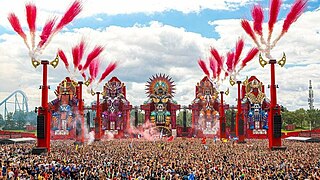History
The hard trance sound developed out of the breakbeat hardcore/hardcore era which itself developed from Belgian New Beat industrial style of Techno. When the hardcore breakbeat production community split into its separate subgenres, hard trance began to develop within the breakbeat hardcore production community. Hard trance went on to become one of the dominant and most successful electronic music styles throughout the 1990s in mainland Europe and around the world. The British electronic music scene split off into other styles such as jungle/drum and bass, hardcore, techno and house.
Popularity, commercialisation and commercial downfall
Remaining popular around 1993–1997 in mainland Europe, hard trance was associated with mega-raves of many thousands of ravers. Many series of compilation CDs came initially from the originators of the sound and the clubs that promoted it. It ultimately went overground and reached commercial status becoming known commercially as "maximaal".
Throughout the 1990s the popularity of the sound caused a flurry of popular and financially successful tracks to be licensed by major record labels, with the sound becoming aggressively marketed through commercial compilations on TV, radio and across the different forms of media. In Belgium hard trance was popular in the 1990s, with the label Bonzai Records and titles such as The First Rebirth by Jones & Stephenson released in 1993, [1] Rave City by Yves Deruyter released in 1993, [2] Let There Be House by Cherrymoon Trax released in 1994, [3] The Wave by The Belgica Wave Party released in 1993, [4] Belgium Jump by Dream Your Dream released in 1993, [5] Back To Reality by Phrenetic System released in 1994. [6]
United Kingdom
The hard trance sound came to the UK via the underground techno community in clubs such as Heaven, Trade, Melt and FF and Fist or through clubs such as The Orbit in Morley and Club UK in London. It never reached the same commercial heights or as on the continental mainland due to British music scene already being widely diversified into styles such as jungle/drum & bass, hardcore and house. However it is frequently played in the free party scene and many clubs and festivals still play it to this day.
New Zealand
New Zealand was late to the party and enjoyed Hard Trance into the mid-2000s. The majority of clubs were centred in the K road region of Auckland and included Kiss, Bed, Stair Case and Jones Bar. Auckland's scene was well supplied and transitioned to drum and bass, breaks and eventually dub step in the late 2000s
Influence on other musical styles
Netherlands
Alongside the birth of hard trance, the same producers and record labels were already producing and developing the jumpstyle sound, the successor of gabber, which was popular in the Netherlands. Jumpstyle used the same sounds as the hard trance sound with faster beat patterns but slightly slower than gabber, this developed directly into hardstyle toward the end of the 1990s, which along hardtechno and hard house came to dominate the harder spectrum of electronic music.[ clarification needed ]
United Kingdom
The sound influenced and led to the development of UK hard house and its subgenres, prior to this style the UK clubs where hard house developed were typically already playing a mixture of harder techno styles, progressive trance, electro and hardstyle incorporating many sounds and influences from each style can be heard across the others.
Spain
Jointly with happy hardcore it evolved into makina.





